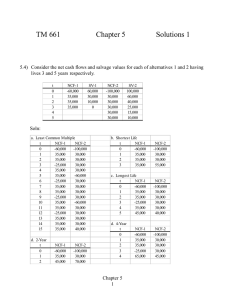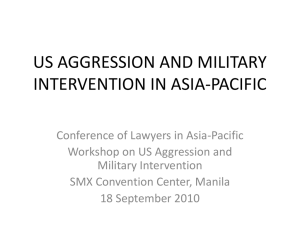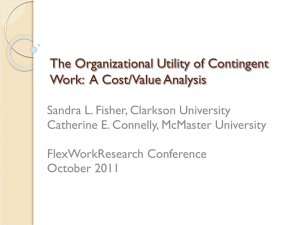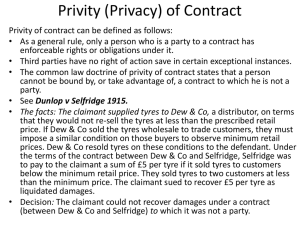Presentation - The Kansas Center for Autism Research and Training
advertisement
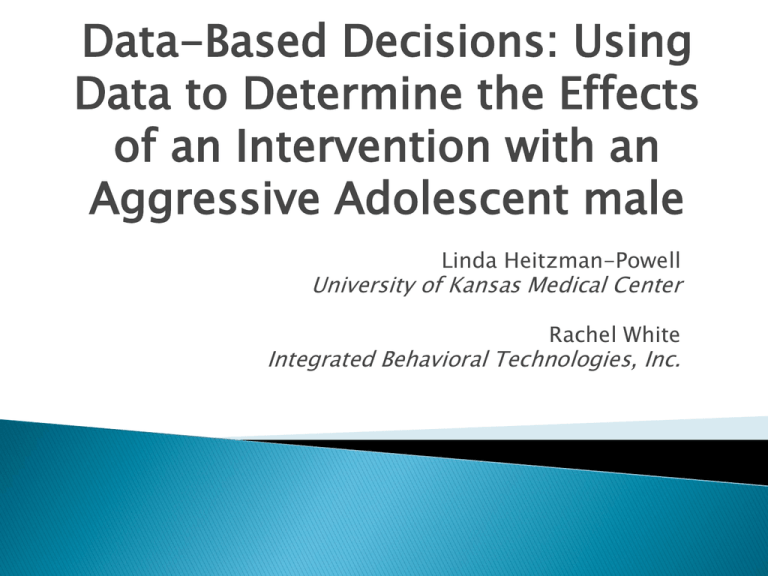
Data-Based Decisions: Using Data to Determine the Effects of an Intervention with an Aggressive Adolescent male Linda Heitzman-Powell University of Kansas Medical Center Rachel White Integrated Behavioral Technologies, Inc. Introduction Despite the efficacy of employing functionbased treatments, non-specific strategies designed to decrease challenging behaviors are implicated under certain conditions: ◦ when maintaining variables cannot be identified or controlled, ◦ when the challenging behavior must be reduced rapidly, ◦ when function based treatment is not sufficient enough (Lerman & Vorndran, 2002), or ◦ when the target behaviors are unresponsive to reinforcement techniques (Luiselli, 1984). Meet Jonathan Jonathan received a diagnosis of Autism when he was four years old. Jonathan has a history of severe aggression, observed both in home and at school. He also has a history of chronic ear infections. His aggression appears to escalate when he is experiencing an infection in his ears. His school aggression was severe enough to warrant a placement in LakeMary Center, an alternative placement for children whom are not able to be served in their home school setting. His home aggression was severe enough that a case manager recommended therapeutic foster-care placement. In June, his current case manager began the reintegration process with in-home behavioral supports. Jonathan currently is on multiple medications to manage his aggressions. Interview ◦ Parent ◦ Caregivers ◦ School Observation ◦ School ◦ Home Real-time data collection Frequency Duration Intensity ABC data Operational Definitions Intensity Scale Defining Data Jonathan engages in a series of behaviors that disrupt his, and others, environments. These behaviors include repetitive vocalizations, hitting, spitting, self-injury, injury to others and property destruction. An event will be considered over when Jonathan has exhibited a quiet body (hands, feet, mouth, and voice) for at least 5 minutes. A new event will be recorded if at least 5 minutes have passed since the end of a previous event. Intensity Scale 1 = pacing or perseverative statements (“moo moo”) 2 = crying or whining 3 = jumping or stomping 4 = screaming or yelling 5 = kicking or tripping 6 = property damage or slamming objects 7 = hitting, grabbing or pushing 8 = scratching or pinching 9 = biting 10 = self-injurious behavior Frequency ◦ Number per day Intensity ◦ Based on scale with behavioral anchors Duration ◦ Based on time July-August Medication Change Only Frequency per Day 10 9 8 7 6 5 4 3 2 1 0 1 2 3 4 5 6 7 8 9 1011121314151617181920212223242526272829303132333435363738394041424344454647 10 Average Intensity per Day 9 8 7 6 5 4 3 2 1 0 1 2 3 4 5 6 7 8 9 1011121314151617181920212223242526272829303132333435363738394041424344454647 Function-based Intervention ◦ Possible functions (suggested by observation and ABC data) Escape from non-preferred activities Access to tangible reinforcers Functional Communication Training ◦ Escape “No thank you” for immediate removal of nonpreferred activities ◦ Access “Water (or any other item he might want) please” ◦ However, escape and access to reinforcers were not always plausible (e.g., activities regarding personal hygiene, access to dangerous materials) 125 121 117 113 109 105 101 97 93 89 85 81 77 73 8 69 65 61 57 53 49 45 41 37 33 29 25 21 17 13 9 9 5 1 Frequency per Day 10 BL Ave per day; range 29-86 per month FCT 7 6 5 4 3 2 1 0 125 121 117 113 109 105 101 97 93 89 85 81 77 73 69 65 61 57 53 49 45 41 37 33 29 25 21 17 13 9 5 1 Ave. Intensity 10 BL Ave Intensity 9 8 7 6 5 4 3 2 1 0 Access to reinforcers not contingent upon any particular behavior – delivered on a continuous schedule No-demand 10 BL FCT NCR/No Demand 9 Frequency per Day 8 7 6 5 4 3 2 1 0 1 2 3 4 5 6 7 8 9 10 11 12 13 14 15 16 17 18 19 20 21 22 23 24 25 26 27 28 29 30 31 32 33 34 35 36 37 38 39 10 BL FCT NCR/No Demand 9 8 7 Ave. Intensity 6 5 4 3 2 1 0 1 2 3 4 5 6 7 8 9 10 11 12 13 14 15 16 17 18 19 20 21 22 23 24 25 26 27 28 29 30 31 32 33 34 35 36 37 38 39 10 BL FCT NCR/No Demand Schedule 9 Frequency per Day 8 7 6 5 4 3 2 1 0 1 2 3 4 5 6 7 8 9 10 11 12 13 14 15 16 17 18 19 20 21 22 23 24 25 26 27 28 29 30 31 32 33 34 35 36 37 38 10 BL FCT NCR/No Demand Schedule 9 8 7 Ave. Intensity 6 5 4 3 2 1 0 1 2 3 4 5 6 7 8 9 10 11 12 13 14 15 16 17 18 19 20 21 22 23 24 25 26 27 28 29 30 31 32 33 34 35 36 37 38 106 103 100 Quiet Room 97 94 91 88 85 82 79 Extinction 76 73 70 67 64 61 58 55 FCT NCR/No Demand Schedule 52 49 46 43 40 37 34 31 28 25 22 19 16 13 10 10 7 4 1 Ave. Intensity BL In-Patient 9 8 7 6 5 4 3 2 1 0 106 103 100 Quiet Room 97 94 91 88 85 82 79 Extinction 76 73 70 67 64 61 58 55 FCT NCR/No Demand Schedule 52 49 46 43 40 37 34 31 28 25 22 19 16 13 10 10 7 4 1 Frequency per Day BL In-Patient 9 8 7 6 5 4 3 2 1 0 Contingent Effort One of the more acceptable and less aversive procedures to de-escalate challenging behavior is contingent effort (Luce, Delquadri, & Hall, 1980). Several studies demonstrated the effectiveness of contingent effort in decreasing challenging behavior beyond or in the absence of reinforcement based intervention. (Experiment I; Luce et al., 1980). Additionally, contingent effort (stacking rings) significantly decreased aggression in both residential and classroom settings (Jackson, Tyminski, Frederick, Neary, & Luce, 2005). Contingent Effort (cont.) Despite successful uses of de-escalation procedures, these studies were conducted at residential or school settings and the extent to which the effectiveness and utility of contingent effort as a deescalation procedure at home setting has not been well reported. Therefore, the present study examined the effectiveness of an existing de-escalation procedure (Jackson et al., 2005) modified for use in the home. Setting and Materials Intervention was conducted at home and during family community outings Materials: ◦ 1 ring stacking base ◦ 5 color rings Procedures Design ◦ Baseline (non-effective contingency management & FCT) Alternating Treatments ◦ Treatment Changing Criterion Initially, during the treatment phase, on the first occurrence of aggression, the child was: ◦ Prompted to move to a designated room by parents or staff ◦ Instructed to sit down and engage in a deescalation contingent effort (i.e., stacking rings). ◦ Required to complete the task calmly (no incidents of aggression) for a period of two minutes. Procedures (cont.) As aggression began to decrease, the criterion for contacting “ring stacking” changed: ◦ Pre-cursor behaviors were targeted 1st criterion change targeted 3 instances of verbal escalation 2nd criterion change targeted 2 instances of verbal escalation 3rd criterion change targeted 1 instance of verbal escalation If any incidents of aggression occurred during all criterion phases, the task was re-presented until he completed the task with no aggressive incidents for two minutes. Rings and the stacking base were available when the child went on an outing Data Recording An Antecedent-Behavior-Consequence (ABC) chart was filled out by parents or staff upon the occurrence of aggression. Aggression was defined as any attempt to hit, scratch, pinch, bite, kick, grab or push a person. ◦ Intensity of each aggressive episode was scored on a scale of 1 to 10 ◦ Duration data was also recorded All Recorded Incidents Intervention - Changing Criterion Contingent Effort 10 Med. Changes, FCT, No Demand Antecedent Control, Consequential Control, etc., Time-out Aggressions 3 Pre-Cursors 2 9 1 8 7 6 5 4 3 2 1 0 Months av e. 04 Se p O ct No v De Ja c n06 Fe b M ar Ap r Ju l Au g Ju n -1 Fe b M ar Ap r M ay 100 95 90 85 80 75 70 65 60 55 50 45 40 35 30 25 20 15 10 5 0 -5 Baseline for Contingent Effort Ju l-0 4 Au g Se p O ct No v De Ja c n05 Number of Incidences True BL (Med change only) Number of aggressive episodes Average intensity Behaviors ◦ Silliness ◦ Non-compliance ◦ Inappropriate Language Conditions ◦ Access Contingent upon expression of the behavior, the student was given the item for 15s ◦ Escape Contingent upon expression of the behavior, the materials were removed and the student was given escape from the task 15s ◦ Play No demands; free access to reinforcers Attention ◦ Noncontingent Reinforcement Timer set for 20m When the timer goes off, Mom/Dad spend 2-3 minutes ◦ Functional Communication Teaching Teach phrases such as “look at me”, “play with me” etc. In the presence of a NO-demand situation (free-time) Model functional communication Require an imitative response Escape ◦ Extinction In the presence of a demand: Do not attend or respond Continue to present demand Function-based Intervention 16 14 12 Aggression Precursors Frequency 10 8 6 4 2 0 June 06 July Aug Sept Oct Nov Dec Jan '07 Feb March April May June July Aug Sept Oct Nov Dec Results – Function-based Intervention Reduced overall number of aggressive behaviors from around 4 episodes per month to 0-6 (first month only) by the end of the reporting period. The intervention also reduced pre-cursor behaviors from between 10 and 14 to between 0 and 4 per month. Discussion Contingent effort can be effectively implemented in a home setting even when trained staff are not readily available. The same procedure has been successfully implemented at his school given the success at home. As the challenging behavior is decreasing, the focus of the intervention needs to shift from decreasing challenging behavior to function-based interventions. Discussion (cont.) Staffing needs ◦ 2004-2005 1:1 25+ hours per week 8-10+ hours per month from consultant ◦ 2005-2006 1:1 15-25 hours per week 4-6 hours per month from consultant ◦ 2007 1:1 10-15 hours per week 2-4 hours per month from consultant ◦ 2008-2009 1:1 <10 hours per week As needed (approximately 2 visits in 2 years) References Jackson, A., Tyminski, J., Frederick, L., Neary, P., & Luce, S. (2005, May). Decreasing aggressive behavior: Utilization of contingent effort as a de-escalation procedure. Poster session presented at the annual meeting of the Association for Behavior Analysis, Chicago, IL. Lerman, D. C. & Vorndran (2002). On the status of knowledge for using punishment: Implications for treating behavior disorders. Journal of Applied Behavior Analysis, 35, 431-464. Luce, S. C., Delquadri, J., & Hall, R.V. (1980). Contingent exercise: A mild but powerful procedure for suppressing inappropriate verbal and aggressive behavior. Journal of Applied Behavior Analysis, 13, 583-594. Luiselli, J. K. (1984). Therapeutic effects of brief contingent effort on severe behavior disorders in children with developmental disabilities. Journal of Clinical Child Psychology, 13, 257-262. Contact Information Linda Heitzman-Powell lhpowell@ku.edu University of Kansas Medical Center 3901 Rainbow Blvd. Phone (913) 945-6604 Rachel White rachelwhite@ibt-inc.org




